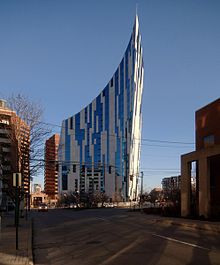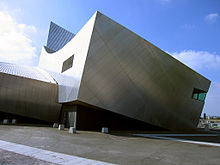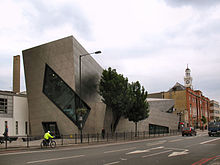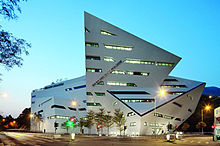- Daniel Libeskind
-
Daniel Libeskind 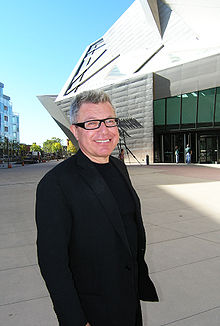
Daniel Libeskind in front of his extension to the Denver Art Museum.Born May 12, 1946
Łódź, PolandNationality American Work Practice Studio Daniel Libeskind Buildings Jewish Museum Berlin
Imperial War Museum North
Contemporary Jewish Museum
Royal Ontario Museum (expansion)Daniel Libeskind, (born May 12, 1946 in Lodz, Poland) is an American architect, artist, and set designer of Polish-Jewish descent. Libeskind founded Studio Daniel Libeskind in 1989 with his wife, Nina, and is its principal design architect.[1] His buildings include the Jewish Museum in Berlin, Germany, the extension to the Denver Art Museum in the United States, the Grand Canal Theatre in Dublin, the Imperial War Museum North in Salford Quays, England, the Michael Lee-Chin Crystal at the Royal Ontario Museum in Toronto, Canada, the Felix Nussbaum Haus in Osnabrück, Germany, the Danish Jewish Museum in Copenhagen, Denmark, and the Wohl Centre at the Bar-Ilan University in Ramat-Gan, Israel.[2] His portfolio also includes several residential projects. Libeskind's work has been exhibited in major museums and galleries around the world, including the Museum of Modern Art, the Bauhaus Archives, the Art Institute of Chicago, and the Centre Pompidou.[3] On February 27, 2003, Libeskind won the competition to be the master plan architect for the reconstruction of the World Trade Center site in Lower Manhattan.[4]
Contents
Personal life
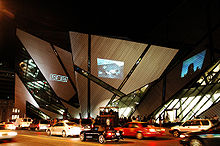 Libeskind's addition to the Royal Ontario Museum in Toronto (2007).
Libeskind's addition to the Royal Ontario Museum in Toronto (2007).
Born in Łódź, Poland on May 12, 1946, Libeskind was the second child of Dora and Nachman Libeskind, both Polish Jews and Holocaust survivors.
As a young child, Libeskind learned to play the accordion and quickly became a virtuoso, performing on Polish television in 1953. He won a prestigious America Israel Cultural Foundation scholarship in 1959 and played alongside a young Itzhak Perlman.[5] That summer, the Libeskinds moved to New York City on one of the last immigrant boats to the United States.
In New York, Libeskind lived in the Amalgamated Housing Cooperative in the northwest Bronx, a union-sponsored, middle-income cooperative development. He attended the Bronx High School of Science. The print shop where his father worked was on Stone Street in lower Manhattan, and Libeskind watched the original World Trade Center being built in the 1960s.[6]
Libeskind became a United States citizen in 1965.[7] In 1970, he received his professional architectural degree from the Cooper Union for the Advancement of Science and Art; he received a postgraduate degree in History and Theory of Architecture at the School of Comparative Studies at Essex University in 1972.
In 1968, Libeskind briefly worked as an apprentice to architect Richard Meier. In 1972, he was hired to work at Peter Eisenman's New York Institute for Architecture and Urban Studies, but he quit almost immediately.[8]
Daniel Libeskind met Nina Lewis, his future wife and business partner, at the Bundist-run Camp Hemshekh in upstate New York in 1966. They married a few years later and, instead of a traditional honeymoon, traveled across the United States visiting Frank Lloyd Wright buildings on a Cooper Union fellowship.[9]
Since then, Libeskind has lived, among other places, in New York, Toronto, Michigan, Italy, Germany, and Los Angeles,[9] and has taught at numerous universities across the world, including the University of Kentucky, Yale University, and the University of Pennsylvania.[7] Since 2007, Libeskind is visiting professor at the Leuphana University Lueneburg, Germany. He is both a U.S. and Israeli citizen[10].
Nina and Daniel Libeskind have three children, Lev, Noam and Rachel.[11]Career
Though he had been an architectural theorist and professor for many years, Libeskind completed his first building at the age of 52, with the opening of the Felix Nussbaum Haus in 1998.[12] Prior to this, critics had dismissed his designs as "unbuildable or unduly assertive."[13] The first design competition that Libeskind won was in 1987 for housing in West Berlin, but soon thereafter the Berlin Wall fell and the project was canceled. Libeskind won the first four projects he entered into competition for.
The Jewish Museum Berlin, completed in 1999, was Libeskind's first major international success and was one of the first buildings designed after reunification. Libeskind has also designed cultural and commercial institutions, museums, concert halls, convention centers, universities, residences, hotels, and shopping centers. Critics often describe Libeskind's work as deconstructivist.[14]
Libeskind is perhaps most famous for being selected by the Lower Manhattan Development Corporation to oversee the rebuilding of the World Trade Center, which was destroyed in the September 11, 2001 attacks. He titled his concept for the site Memory Foundations.
Studio Daniel Libeskind, headquartered two blocks south of the World Trade Center site in New York, is currently working on over 40 projects across the world. The studio's most recent completed projects include the Contemporary Jewish Museum in San Francisco, California, The Ascent at Roebling's Bridge in Covington, Kentucky, and the Royal Ontario Museum in Toronto, Ontario.
In addition to his architectural projects, Libeskind also designs opera sets for productions such as the Norwegian National Theatre's The Architect in 1998 and Saarländisches Staatstheater's Tristan und Isolde in 2001. He also designed the sets and costumes for Intolleranza by Luigi Nono and for a production of Messiaen's Saint Francis of Assisi by Deutsche Oper Berlin. He has also written free verse prose, included in his book Fishing from the Pavement.[15]
Work
The following projects are listed on the Studio Daniel Libeskind website. The first date is the competition, commission, or first presentation date. The second is the completion date or the estimated date of completion.
Completed
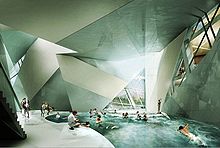 Westside interior, 2008
Westside interior, 2008
- 1989–1999 Jewish Museum Berlin - Berlin, Germany
- 1995–1998 Felix Nussbaum Haus - Osnabrück, Germany
- 1997–2001 Imperial War Museum North - Greater Manchester, England
- 1998–2008 Contemporary Jewish Museum - San Francisco, California, United States
- 2000–2003 Studio Weil - Majorca, Spain
- 2000–2006 Extension to the Denver Art Museum, Frederic C. Hamilton Building - Denver, Colorado, United States
- 2000–2006 Denver Art Museum Residences - Denver, Colorado, United States
- 2000–2008 Westside Shopping and Leisure Centre - Bern, Switzerland
- 2001–2003 Danish Jewish Museum - Copenhagen, Denmark
- 2001–2004 London Metropolitan University Graduate Centre - London, England
- 2001–2005 The Wohl Centre - Bar-Ilan University, Ramat-Gan, Israel
- 2002–2007 Michael Lee-Chin Crystal, extension to Royal Ontario Museum and renovation of ten of its existing galleries - Toronto, Ontario, Canada
- 2003–2005 Tangent, Facade for Hyundai Development Corporation Headquarters - Seoul, South Korea
- 2004–2005 Memoria e Luce, 9/11 Memorial - Padua, Italy
- 2004–2007 Glass Courtyard addition to the Jewish Museum Berlin - Berlin, Germany
- 2004–2008 The Ascent at Roebling's Bridge, residential condominium building - Covington, Kentucky, United States
- 2005–2009 MGM Mirage's CityCenter, retail and public space on the Las Vegas Strip - Las Vegas, Nevada
- 2004–2010 Grand Canal Square, Grand Canal Theatre and Commercial Development - Dublin, Republic of Ireland
- 2010 Wheel of Conscience monument, M.S. St. Louis Memorial, Pier 21 - Halifax, Canada
- 2001–2011 Military History Museum - Dresden, Germany
- 2002–2011 Run Run Shaw Creative Media Centre - Hong Kong
Under construction
- 2003–2012 One World Trade Center - New York City, New York
- 2005–2012 Złota 44, apartment tower - Warsaw, Poland
- 2005–2011 L Tower and Sony Centre for the Performing Arts Redevelopment - Toronto, Canada
- 2006–2011 Reflections at Keppel Bay, high-rise and low-rise villa apartment blocks - Keppel Bay, Singapore
- 2009–2014 Kö-Bogen, Königsallee, Düsseldorf, Germany
Proposed/In Design
- 2004–2010 New Center for Arts and Culture - Boston, Massachusetts, United States
- 2004–2014 CityLife (Milan) - Milan, Italy
- 2005–? Edwards Condominiums, urban infill residential and commercial spaces - Edwards, Colorado, United States
- 2006–? Ørestad Downtown Master Plan, urban development - just south of Copenhagen, Denmark
- 2006–? Rejuvenation, Forest Heights Boys and Girls Club - Gulfport, Mississippi, United States
- 2006–2011 Haeundae Udong Hyundai I'Park, five waterfront towers - Busan, South Korea
- 2006–2013 New Songdo City, shopping mall, department store, cinema, ice rink, food court in Riverstone complex - Incheon, South Korea
- 2004–2010 Editoriale Bresciana Tower, 23-story office and luxury apartment building - Brescia, Italy
- 2007–2009 18.36.54, residence - Connecticut, United States
- 2010–2013 Tampere Central Arena - Tampere, Finland
- 2011–2015 Beth Shalom, liberal Synagogue - Munich, Germany
- 2011–2015 Convention Center of Mons, Belgium
Unbuilt
- 'The Spiral' extension to the Victoria and Albert Museum, London, was canceled following its failure to attract funding from the Heritage Lottery Fund
Recognition
- Gold medal for Architecture at the National Arts Club (2007)
- RIBA International Award for Wohl Centre at Bar-Ilan University (2006)
- RIBA International Award for the Imperial War Museum North (2004)
- RIBA Award for the London Metropolitan University Graduate Centre (2004)
- Appointed as the first Cultural Ambassador for Architecture by the U.S. Department of State (2004)[16]
- Honorary member of the Royal Academy of Arts in London, England (2004)
- Man of the Year Award from the Tel Aviv Museum of Art (2004)
- First architect to win the Hiroshima Art Prize, awarded to an artist whose work promotes international understanding and peace (2001)[17]
- Goethe Medal for cultural contribution by the Goethe Institute (2000)
- Time Magazine Best of 1998 Design Awards for the Felix Nussbaum Haus (1998)
- Elected to the American Academy of Arts and Letters (1996)
- Venice Biennale First Prize Stone Lion Award for Palmanova Project (1985)
- National Endowment for the Arts Design Arts Grant for Studies in Architecture (1983)
- American Institute of Architects Medal for Highest Scholastic Achievement (1970)
- First recipient of honorary degree of Doctor of Fine Art (DFA) from University of Ulster in recognition of his outstanding services to global architecture and design (2009)[18]
- In 2003, he received the Leo Baeck Medal for his humanitarian work promoting tolerance and social justice.
Bibliography
- Daniel Libeskind: Countersign (1992) (ISBN 0-8478-1478-5)
- Daniel Libeskind Radix-Matrix (1997) (ISBN 3-7913-1727-X)
- Jewish Museum Berlin (with Helene Binet) (1999) (ISBN 90-5701-252-9)
- Daniel Libeskind (2001) (ISBN 0-7893-0496-1)
- Breaking Ground (2004) (ISBN 1-57322-292-5)
- Counterpoint (2008) (ISBN 1-58093-206-1)
References
- ^ Libeskind, Daniel (2004). Breaking Ground. New York: Riverhead Books. p. 88. ISBN 1-57322-292-5.
- ^ Studio Daniel Libeskind. "Projects". http://www.daniel-libeskind.com/projects/show-all/. Retrieved June 12, 2008.
- ^ Studio Daniel Libeskind. "Exhibitions". http://www.daniel-libeskind.com/studio/exhibitions/. Retrieved July 29, 2008.
- ^ Rochan, Lisa. "Libeskind shows genius for complexity", "The Globe and Mail", February 28, 2003
- ^ Royal Ontario Museum. "Hiroshi Sugimoto-Daniel Libeskind: The Conversation". http://www.rom.on.ca/news/releases/public.php?mediakey=2zo8f8skvj. Retrieved June 12, 2008.
- ^ Libeskind, Daniel (2004). Breaking Ground. New York: Riverhead Books. pp. 11, 10, 35. ISBN 1-57322-292-5.
- ^ a b Studio Daniel Libeskind. "Studio Daniel Libeskind: Daniel Libeskind". http://www.daniel-libeskind.com/studio/daniel-libeskind/. Retrieved June 12, 2008.
- ^ Libeskind, Daniel (2004). Breaking Ground. New York: Riverhead Books. p. 41. ISBN 1-57322-292-5.
- ^ a b Davidson, Justin (October 8, 2007). "The Liberation of Daniel Libeskind". New York Magazine. pp. 56–64.
- ^ See, Frequent Flyer. When the Wife is a Lucky Charm, Don't Leave Home Without Her. The New York Times, Tuesday, August 9, 2011, p. B6.
- ^ Jewish Museum Berlin. "Jewish Museum Berlin - Daniel Libeskind". Archived from the original on October 13, 2007. http://web.archive.org/web/20071013202822/http://www.juedisches-museum-berlin.de/site/EN/05-About-The-Museum/03-Libeskind-Building/07-Libeskind/daniel-libeskind.php. Retrieved February 25, 2009.
- ^ Yu, Myung-hee (2007). Daniel Libeskind. OPUS 1946-present. South Korea: I-Park. p. 34. ISBN 1-57322-292-5.
- ^ Pearman, Hugh (July 27 - August 1, 1998). "Walls hold back the forgetting". Zeitgeist. pp. 26–27.
- ^ Erbacher, Doris and Kubitz, Peter Paul. "'You appear to have something against right angles", "The Guardian", October 11, 2007
- ^ Davies, Colin. "Fishing From the Pavement – Book Reviews", "The Architectural Review", April 1998
- ^ Sinoo, Ola europe-re.com[dead link] "What's the Added Value of Architecture?", "Europe Real Estate Yearbook", 2008
- ^ Hiroshima City. "General Description of the Hiroshima Art Prize". http://www.city.hiroshima.jp/e/overview/add/hap/hap.html. Retrieved August 3, 2008.
- ^ University of Ulster Honours World-Leading Architect Daniel Libeskind University of Ulster News Release, November 11, 2009
External links
- Official Studio Libeskind homepage
- Voices on Antisemitism Interview with Daniel Libeskind from the United States Holocaust Memorial Museum
- House Living And Business Interview with Daniel Libeskind
- Daniel Libeskind Revealed on CNN.com (videos)
- Guardian interview
- Daniel Libeskind on Artabase
- designboom.com interview
- Hugh Pearman interview
- "Architecture is a communicative art" Lecture by Daniel Libeskind
- Architecture: the Future of Memory, video lecture
- National Review Report "Shred the Libeskind Blueprints"
- Rebuilding the rubble - The Guardian, June 29, 2002. In-depth interview and profile
- 2006 Open Source Mentoring Interview with Daniel Libeskind
- Interview:Daniel Libeskind - The belly of an architect
- Photo Gallery of The Ascent
- On-line video interview for Czech TV (22. 8. 2010)
- Daniel Libeskind papers, 1968–1992 Research Library at the Getty Research Institute, Los Angeles, California:
- The Libeskind papers, 1970–1992, are composed of architectural drawings, notebooks, sketches, models, letters, press clippings, transparencies and videotapes which document Libeskind's design for the Jewish Museum extension to the Berlin Museum (Jüdisches Museum im Berlin Museum), 1988–1992. Libeskind called this project Between the Lines. The archive also contains 14 other design projects (1970–1991), materials related to Libeskind's teaching at the Cranbrook Academy of Art (1978–1985), manuscripts for publications and lectures, and photographs and transparencies related to these activities.
Categories:- Daniel Libeskind buildings
- American architects
- Jewish architects
- Postmodern architects
- Deconstructivism
- American people of Polish-Jewish descent
- Polish Jews
- Naturalized citizens of the United States
- Polish emigrants to the United States
- The Bronx High School of Science alumni
- Cooper Union alumni
- Alumni of the University of Essex
- Accordionists
- People from Łódź
- People from the Bronx
- 1946 births
- Living people
Wikimedia Foundation. 2010.

